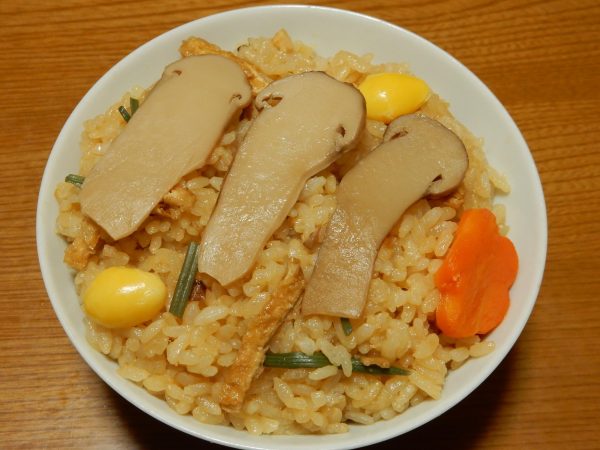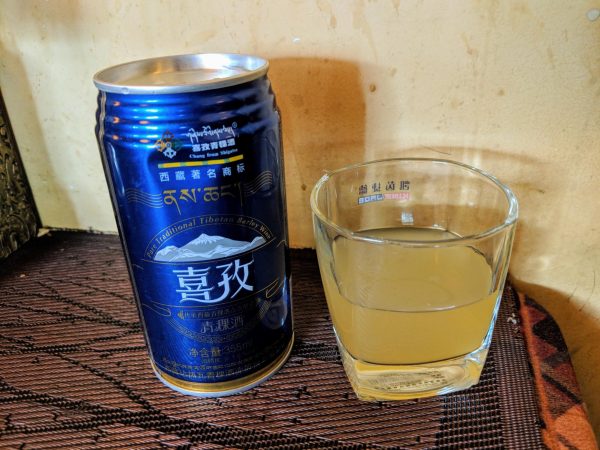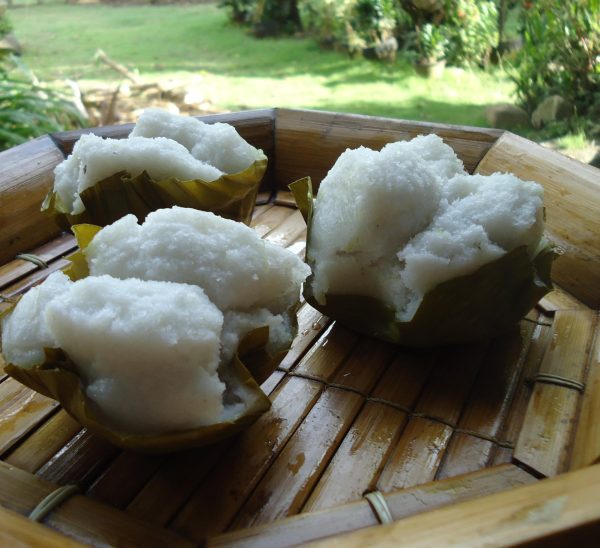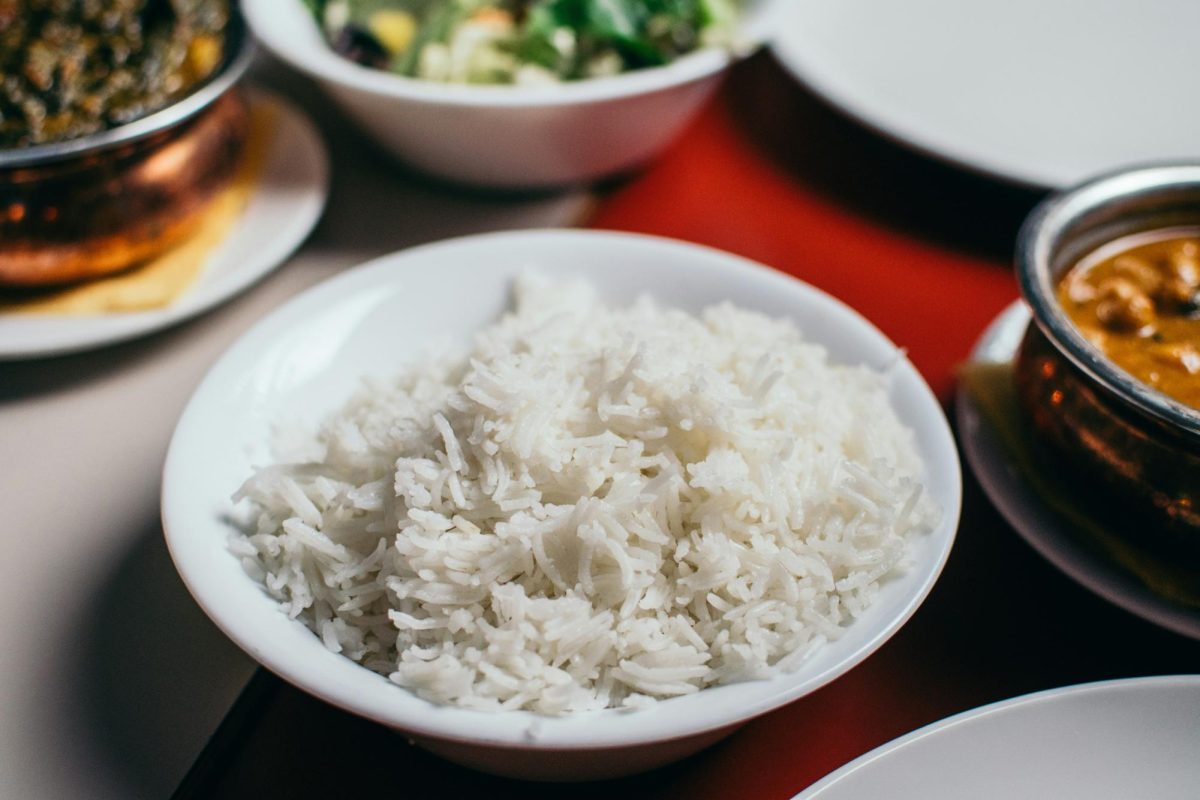About a month ago, my mother bought a new rice cooker. Leading up to that, we had been using an old rice cooker that one of her friends had given. By then, we’d used the rice cooker for 7 or so years, and the wear meant the rice would turn out unevenly cooked. The sides would be mushy, as if we’d used too much water, but the center would be dry.
Of course, bad rice meant bad rice dishes, so my mother had started cooking with more noodles to make up for it. My father, who lives in Queens, cooks rice for my sibling and I with nearly every meal, so I didn’t feel very lacking with plain rice. But when I was thinking of ideas for my article for this issue, my friend brought up the topic of comfort meals. Then, I was hit with a realization: I missed my mother’s rice dishes. I asked her that day to make takikomi-gohan.
Overview
Rice, a staple for more than one third of the world’s population, was first cultivated in the Yangtze River basin in China 12,000 to 8,000 years ago. There are two main varieties of the rice that originate there. Japonica, commonly seen in East Asian countries such as Korea, China, and Japan, and indica, commonly seen in countries such as Pakistan, India, Indonesia, and African countries. Other varieties also include glutinous rice (used in mochi, my personal favorite) and aromatic rice (such as basmati rice, often used in pilafs/plovs/pulaos).
Over 3.5 billion people around the word consume rice as a staple. Because of its widespread appearances in diets, rice is a part of many religious and cultural practices. Throwing rice at weddings is common across a wide variety of cultures, symbolizing wealth, good health, and fertility, and rice wine also makes a common appearance as part of rites. Countries such as Cambodia and Thailand have royal plowing ceremonies, and Nepal has National Paddy Day to mark the beginning of the rice planting season. Traditional foods made from rice are eaten during festivals and holidays, specialized throughout regions. It’s clear then, that rice is an integral part of many people’s cultures and lives.
For many people from immigrant families, food and drinks can be one of the greatest connections to their cultures that is available to them. Household recipes passed on from their parents, snacks bought at gems of specialized grocery stores, the joy you get from meeting people from your culture and bonding over your favorite dishes— food has the ability to bring a special type of joy into our lives.
Biryani: South, Central, Western, and Southeast Asia

(Photo Credit: Behrouz Biryani, CC BY-SA 2.0 <https://creativecommons.org/licenses/by-sa/2.0>, via Wikimedia Commons)
Biryani most likely originated in modern-day Iran. The name biryani comes from the Persian word for rice, birinj (برنج), or beriyan (بریان), meaning “to fry.” A popular theory suggests that this dish was invented by the Mughals and later spread to other regions, though others contest that there is evidence of biryani spreading to regions before the arrival of the Mughals.
The main ingredients are marinated meat (often chicken, beef, goat, but lamb, fish, or prawn may also be used), and spiced rice. The meat and rice are seasoned with a variety of spices, such as chili, paprika, cardamom, bay leaf, and onion. Individuals can make their own seasoning mix, or buy premade seasoning packets. Yogurt is also commonly added at the bottom for additional flavor and moisture.
There are two styles of Biryani, kacchi (“raw”) and pakki (“cooked”). Pakki biryani involves partially cooking the meat, vegetables, and rice separately, before combining them into layers in one cooking vessel to cook the rest of the way through. In kacchi biryani, the ingredients are layered raw in one vessel, before cooking or baking all the ingredients together. Potatoes usually comprise the bottom layer, as they are hard to burn. The layers of rice in both types of dishes may use different spices, like turmeric or saffron.
Biryani’s widespread popularity across Asia makes it a staple dish for many households. Its wide variety of options for ingredients means that every family has their own variation, their own taste. “You learn a lot of stuff just by making it,” said Maheen Alam ’25 (he/him). “I was…the only Bengali kid in that [elementary] school…I remember everyone really liking it…just like being really curious about it and asking how to make it,” he said, “It’s a source of pride… in our culture.”
However, he didn’t always like biryani. What got him to change his mind was when his cousins visited the U.S. from Bangladesh for the first time for Eid. America is diverse, but much of the cultural food brought over has changed forms, either from lack of traditionally used ingredients or simply from lack of familiarity with its flavors. “They had a lot of ingredients from Bangladesh that are hard to find here,” Alam said.
Their cooking was the first time he had such a striking experience with Biryani, and over the years, he’s grown much more accustomed to it. Many foods can be that way— individuals’ tastes change over time, even more so for children of immigrant families who may be more used to tasting American foods from lack of availability.
Takikomi-gohan (炊き込みご飯): Japan

This is a type of takikomi-gohan, matsutake-gohan, commonly eaten during the fall when matsutake can be harvested. It’s also topped with ginnan (銀杏, or ginkgo nuts), which are ginkgo tree seeds, another ingredient harvested during the fall. Takikomi-gohan, also known as kayaku-gohan (かやくご飯) in the Kansai region of western Japan and gomoku-gohan (五目ご飯), originated during the Nara-period during the 8th century AD. During this period, commoners could not grow enough rice for everybody to eat, so they would mix in millet. Other ingredients such as potatoes and weeds were mixed in as well. This early version of takikomi-gohan was called katemeshi (かて飯), also popular during the Meiji era for peasants. This eventually evolved to include a wider variety of ingredients depending on what is available during the season.
The process of making it is extremely simple: either cook the other ingredients separate from the rice first in dashi stock and cook the rice with the other ingredients on top during the same stock, or simply put all the ingredients into the rice cooker at once. The amount of water used to cook the rice depends on what type of rice you’re using, but generally sticky rice (glutinous rice) requires less water than short grain rice (japonica rice), so the amount of water required differs depending on the maker’s rice ratio preference.
Takikomi-gohan is great because there’s a lot of versatility in what you put into it. How much of each ingredient you put into the dish is entirely up to you, so each person’s recipe is unique to them. My mother’s cooking most commonly uses peas to make mame-gohan (豆ご飯), or bamboo shoots, clams, shiitake, carrots, and anything else that catches her eye to make her own variety. My family is especially fond of mushrooms and seafood, so we often add extra. I’ve even seen a recipe where frozen potstickers are cooked on top of the rice and broken apart so the insides of the potstickers are inside the rice. There’s a lot of room for experimentation with even just the amount of dashi and soy sauce you put into it (if you choose to put in any at all), so everyone who has grown up eating takikomi-gohan has their own unique taste of home.
Chang (ཆང): Tibet

Chang (also spelled in a variety of other ways, such as chhaang and chyang) is a type of Tibetan beer, made of rice, millet, or barley. It’s served during Losar (ལོ་སར་), Tibetan New Year. Losar is observed in multiple regions, including India, Tibet, Nepal, and Bhutan, where the recipe for Chang varies depending on the region.
Chang only requires three ingredients: grain, water, and a type of Tibetan yeast called pab/chanzi. The process, however, is a lot more complex. “It seems so simple to make…the tricky part is making sure it ferments without going bad,” said Anna Tsomo (she/they), a Tibetan American afterschool program director at the Sixth Street Community Center, which focuses on climate, social, and food justice.
Dre-chang (rice chang) is made by first cooking the rice as you normally would, and grinding up the pab into powder form. The pab is mixed with the rice, and put into a large container with a lid. During the mixing process, if the temperature isn’t just right, the chang can turn sour if too hot, or the fermentation process will take longer than expected if too cold. After, the container is wrapped in blankets and stored in a place with constant temperature. The surrounding temperature has to be warm enough for the yeast to work, but not too hot, because the rice could end up rotting. The longer you let it sit, the stronger the alcohol will be, but you can also water it down at the end.
You can drink the chang in two different ways, the first is by straining the rice out and drinking just the liquid. The alternative is using the rice mixture to make changkol, a dish eaten on the first day of Losar. The process requires lots of care and practice, a testament to the long history being passed down through generations.
Since Chang is drunk during Losar, people naturally associate the drink with family and festivities. “My momo la (grandmother) always makes this drink for Losar (Tibetan New Year) celebrations,” Tsomo told me. “It makes me feel connected to my culture and the many Tibetans all over the world who drink chang during Losar.”
Even if there aren’t many people from your culture and family present in the country, the knowledge that what’s filling your belly is the culmination of decades, centuries, or even millennia of tradition passed down from your ancestors can be a comforting reminder.
Puto Bigas: Philippines

Puto bigas, also known as puto puti, putong bigas (“rice cake”), or putong puti (“white cake”) is a steamed snack made from galapong, fermented rice. The person who told me about this dish, Matthew Rustia (he/him), a student at the afterschool program I go to, hilariously wrote,“It [the name] is also a Spanish profanity!” Puto is a type of kakanin, which is the umbrella term for snacks made from rice and coconut milk.
To make puto, you will need a steamer and some molds (muffin trays are usually the most readily available). Start by making the galapong by whisking rice flour, salt, baking powder, and sugar. Then, add water and coconut milk, mixing well, before covering the bowl and putting it in the fridge overnight, or letting it sit on the counter for about 4 hours. This allows for the batter to ferment. After the batter has fermented, line your mold something to prevent it from sticking to the pan. If the traditionally used banana leaves aren’t available, use cooking oil, butter, or a cupcake mold. Pour batter into molds so each is about ¾ full. Then, steam the puto for about 30 minutes, or until it passes the toothpick test. Let cool, and serve! You can personalize the flavor if you add ube (purple yam) or any other coloring or flavoring to the recipe.
Puto is very commonly eaten with dinuguan, pig’s blood stew, or a little bit of cheese on top, but its versatility is one of the things that makes it so popular. As a snack, it’s enjoyed by people of all ages. Rustia mentioned, “After church every Sunday my dad and I would always go eat lunch at the Filipino store in Queens Village…It was a weekly ritual for us that for desert, we would have puto with a little cheese on top. It is a staple of my childhood and always brings back warm feelings.”
How rice connects people
These four are just a tiny portion of the countless number of rice dishes, drinks, and snacks worldwide. From my preliminary research alone, I found La Bandera from the Dominican Republic, Dosa from South India, Korvstroganoff from Sweden, Kheer from South Asia, Congee from China, Nasi Lemak from Malaysia, and the numerous varieties of plov (also called pilaf, pulao, and by many other names) around the world.
Food is vital to us all because it not only nourishes us, but it also connects people. Families surround dinner tables talking about their days, children trade snacks during lunchtime, and friends split fruit amongst themselves. Eating together and sharing food is considered one of the most intimate things we can do.There’s no denying then, that rice, a food that’s found across the globe, is considered so important. Its versatility allows for billions of people to create new dishes and pass down old ones, connecting them across thousands of miles and hundreds of generations.
As a major food staple for many immigrant cultures, rice is a key ingredient in the foods that connect people to their backgrounds. Even if a child of an immigrant family can’t speak the same language or doesn’t know cultural nuances that their extended family may, shared recipes can bridge the gap. Even between different cultures, there are similarities in dishes and practices that can lead to bonds forming. Food can nourish not only the body, but also the soul.
For many people from immigrant families, food and drinks can be one of the greatest connections to their cultures that is available to them. Household recipes passed on from their parents, snacks bought at gems of specialized grocery stores, the joy you get from meeting people from your culture and bonding over your favorite dishes — food has the ability to bring a special type of joy into our lives.

